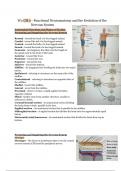Class notes
PSYB64 Chapter 2 notes - UTSC
- Course
- PSYB64 (PSYB64)
- Institution
- University Of Toronto (U Of T )
Detailed notes from Chapter 2 - Functional Neuroanatomy and the Evolution of the Nervous System. Freberg, L. (2018). Discovering Behavioral Neuroscience: An introduction to Biological Psychology. Cengage Learning.
[Show more]



